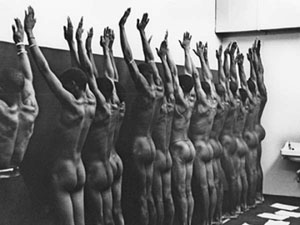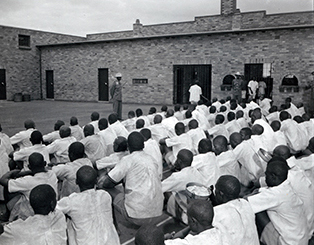Prison labour has a particularly debatable history in South Africa. Historically, South Africa operated on the understanding that prisons were places of punishment which was mainly executed through forced prison labour. By the late 1800s, the idea of imprisonment shifted with the aim to rehabilitate prisoners. Central to this concept was the idea that rehabilitation could be usefully achieved through the labour of prisoners. This was often supported by an ideology that labour was a means of introducing ‘civilisation’ to Africans. With the abolition of slavery in 1834, convicts played a crucial role in providing much needed cheap labour. The enforcement of laws regulating the movement of indigenous people later provided sufficient prisoners to contribute to the labour demand.
Under colonialism, prison camps were widely used by colonial rulers to ensure an accessible supply of forced labour. Mass arrests and detention without trial led to overpopulated prisons and the colonial powers used this to their advantage. The colonial empires were built on the backs of their prisoners who provided cheap, docile and constantly available labour force for underpaid tasks. During the 1840s and 1850s, convicts were made to work on public projects, particularly building roads and later ships. Prison labour was also used in the development of roads, railways and forestry.
With the discovery of diamonds and gold, the demand for labour increased. In 1885, the De Beers Diamond Mining Company became the first private organisation to employ convicts for labour. The prison supplemented the labour force, as many workers spent time in prison as a consequence of the pass laws. Therefore, the population of both compounds and prisons consisted not only criminals in the ordinary sense, but of a new labouring population criminalised by laws and controlled in new institutions. De Beers Company went one step further by building a branch prison which was controlled by the company. Then, the role of the State as the provider of unskilled black labour for the mines through the penal system had become manifest. In addition, the penal policy that emerged was the first attempt to segregate prisoners along racial lines. Mine owners treated white workers differently from black workers.
Prisoners were forced to do hard labour. For example, political prisoners on Robben Island worked mainly in quarries. A particularly notorious place was the quarry in Barberton, Eastern Transvaal (now Mpumalanga Province), where prisoners, categorised as group D, worked in cages, meant to prevent them from assaulting each other. On 29 December 1982, several prisoners died there, allegedly of heat prostration. The quarry no longer exists.
 Prisoners during group medical examination. Photograph by Ernest Cole
Prisoners during group medical examination. Photograph by Ernest Cole
During the great depression in the 1930s, prison labour was made available to the agricultural sector at a very low cost. Farms such as the Glenroy sugar cane farm, situated near Dududu on the South Coast of Natal (now Kwazulu Natal province), had bought prisoners to work on the farm. The prison labourers were bought from Durban Central Prison, for 5 cents. Some of the prisoners were from townships surrounding Durban, such as Umlazi. Other prison labourers died on the farm and were buried there. They died from illnesses such as tuberculosis. The farm is now owned by Illovo sugar.
The farmers paid the government a certain amount per convict. The farmers also built prison outstations where the prisoners were housed and fed at their own expense. This continued for decades. Attempts to reform this system were made by the South African Institute of Race Relations (SAIRR) which appointed the Landsdown Commission in 1945. A series of reforms were suggested. However, the South African government of the time was not sympathetic to the Commission’s proposals.
The later use of Black prisoners who were outsourced to private farms for farm labour was justified by the discriminatory notion that non-Europeans were more appropriate to unskilled and outdoor work. John Vorster, minister of Justice at that time, saw this as something that enabled the government to develop self-discipline and a positive approach to work in general. This favoured his eventual rehabilitation. Under apartheid, thousands of black prisoners, and those who had contravened the pass laws, were supplied to farmers as labour. Prisoners were often accommodated on farm outstations. Conditions on prison farms and mine compounds were regularly exploitative and harsh and employers were very not often held accountable for the treatment of prisoners.
In 1959, a major new prison legislation, Prison Act of 1959, was introduced which was based on the policy of apartheid and entrenched the racial segregation of prisons. This not only meant the segregation of whites and blacks, but also the ethnic separation of black prisoners. The Act not only implemented a two-stream correctional policy for Black and European convicts, but also, to a lesser extent, special arrangements for members of different African groups in one institution. Placing the Black convicts in a correctional institution for people of their own group and race not only recognised ethnological differences but was in accordance with the national policy of separate development.
After 1959, prisons were managed under the rules of apartheid and the militaristic approach increased. At first, prisons were not used on a large-scale to control political unrest. However, this soon changed in the post-Sharpeville period of the early 1960s, when the imprisonment of political detainees and sentenced political prisoners became a feature of South African prisons. The detention of high profile political prisoners raised great concern among international organization such as the Red Cross, the United Nations and Amnesty international.
 Bethal Prison Farm. Photograph by Margaret Bourke-White
Bethal Prison Farm. Photograph by Margaret Bourke-White
In addition, there were gross human rights violations in South African prisons. Most prisoners were held in overcrowded communal cells, a situation which persisted for a long time. For example, in August 1992, Human Rights Watch found that Pollsmoor was 97 per cent overcrowded. Such cells did not have beds and most prisoners slept on the floor on mats. The significance of the mine compound in the development of the prison in South Africa did not disappear as the labourers of mine compounds were housed in conditions similar to those of prisoners.
Eventually, as a result of local and international pressure, the prison labour system was discontinued. Prison outstations were closed down in 1988 and there was a decline in the use of prison labour and paroling prisoners under conditions of paid contract. The adoption of a Bill of Rights in 1993 guaranteeing the rights of all people led to fundamental shifts in the philosophy regarding imprisonment and the treatment of prisoners. International standards of imprisonment finally began to impact on local conditions, and the introduction of the Correctional Services Act 111 of 1998 sought to govern the rights, treatment and conditions of all prisoners within a human rights context. The labour practices adopted in the past serve to illustrate the potential for prisoners to be abused and exploited in performing labour during their imprisonment. The international human rights system aims to protect against such abuse.